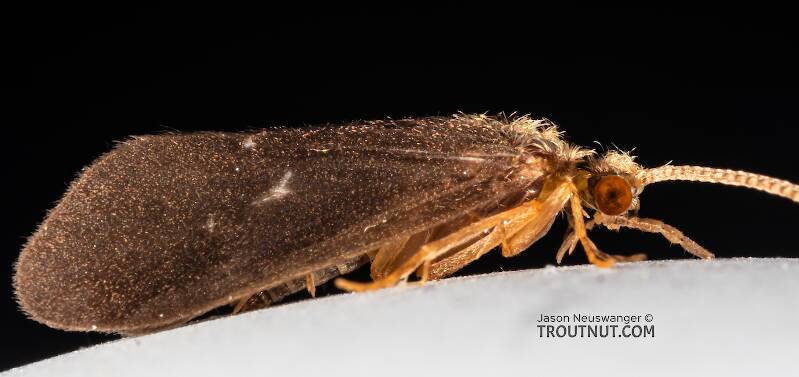
Salmonflies
Pteronarcys californica
The giant Salmonflies of the Western mountains are legendary for their proclivity to elicit consistent dry-fly action and ferocious strikes.
Featured on the forum

I caught this tiny larva without a case, but it seems to key pretty clearly to to Glossosomatidae. From there, the lack of sclerites on the mesonotum points to either Glossosoma or Anagapetus. Although it's difficult to see in a 2D image from the microscope, it's pretty clear in the live 3D view that the pronotum is only excised about 1/3 of its length to accommodate the forecoxa, not 2/3, which points to Glossosoma at Couplet 5 of the Key to Genera of Glossosomatidae Larvae.

Troutnut is a project started in 2003 by salmonid ecologist Jason "Troutnut" Neuswanger to help anglers and
fly tyers unabashedly embrace the entomological side of the sport. Learn more about Troutnut or
support the project for an enhanced experience here.
Caddisfly Genus Nyctiophylax (Dinky Light Summer Sedges)
Genus Range
Egg-Laying behavior
Females lay their eggs underwater, either by diving through the surface or crawling down streamside rocks and twigs.Larva & pupa biology
Current speed: Slow
Shelter type: Unusual retreat; see notes
The small, yellow-and-brown larvae of this genus builds a chamberlike retreat, open at both ends, over a hollow in a stick or rock. It leaves loose threads over each opening and when a smaller animal touches the retreat, disturbing the threads, this eight- to ten-millimeter carnivore rushes out and seizes its prey.
Specimens of the Caddisfly Genus Nyctiophylax
1 Adult

This specimen is certainly Nyctiophylax and most likely Nyctiophylax affinis. I don't know my caddisfly parts well enough to definitively follow the Nyctiophylax key in Morse (1972), but that source states that affinis is the predominant Midwestern species, being widespread and common in the region where I found this one. The anatomy of this one seems to match those at least as well as the other two potential options based on range, Nyctiophylax uncus and Nyctiophylax banksi.
Start a Discussion of Nyctiophylax
References
- LaFontaine, Gary. 1981. Caddisflies. The Lyons Press.
- Swisher, Doug and Carl Richards. 2000. Selective Trout. The Lyons Press.
Caddisfly Genus Nyctiophylax (Dinky Light Summer Sedges)
Taxonomy
7 species (Nyctiophylax banksi, Nyctiophylax barrorum, Nyctiophylax denningi, Nyctiophylax morsei, Nyctiophylax serratus, Nyctiophylax uncus, and Nyctiophylax vestitus) aren't included.

